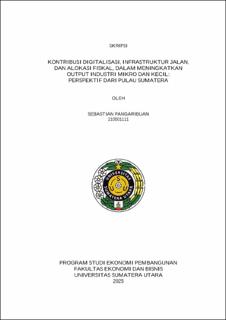| dc.contributor.advisor | Nasution, Inggrita Gusti Sari | |
| dc.contributor.author | Pangaribuan, Sebastian | |
| dc.date.accessioned | 2025-04-11T03:47:05Z | |
| dc.date.available | 2025-04-11T03:47:05Z | |
| dc.date.issued | 2025 | |
| dc.identifier.uri | https://repositori.usu.ac.id/handle/123456789/102857 | |
| dc.description.abstract | Micro and Small Industry (IMK) play a strategic role in Indonesia's economy, particularly in providing employment and driving regional economic growth. However, their contribution to the Gross Regional Domestic Product (GRDP) in Sumatra remains relatively low, with a much smaller output proportion compared to medium-sized enterprises. The role of society as human resources and the government as policymakers is crucial in enhancing IMK productivity through aspects such as digitalization, infrastructure development, and fiscal allocation. Digitalization improves production efficiency and market expansion, while road infrastructure influences the mobility of production factors, and fiscal allocation aims to support sectoral development, though its effectiveness needs further evaluation. Thus, this study aims to assess the contribution of digitalization, road infrastructure, and fiscal allocation in increasing the output of Micro and Small Industries across 10 provinces in Sumatera from 2017 to 2023.
This study employs a quantitative research approach using secondary data published by Statistics Indonesia (BPS), the Ministry of Public Works and Housing (PUPR), and the Directorate General of Fiscal Balance (DJPK). The digitalization aspect is proxied by the ICT Access & Infrastructure Index (IAI) and the ICT Usage Index (IP). The road infrastructure aspect is represented by the Total Road Length (TPJ) and the Road Quality Length (PKJ). Meanwhile, fiscal allocation is proxied by the Special Allocation Fund for Cooperatives and MSME Capacity Building (DAK). The analysis technique used in this study is panel data regression, with the Random Effect Model (REM) as the selected model.
The results show that, partially, the variables IAI, IP, and TPJ have a positive effect on IMK output, while PKJ and DAK have a negative effect. Simultaneously, all variables have a positive and significant impact on IMK output across 10 provinces in Sumatera from 2017 to 2023. | en_US |
| dc.language.iso | id | en_US |
| dc.publisher | Universitas Sumatera Utara | en_US |
| dc.subject | Digitalization | en_US |
| dc.subject | Road Infrastructure | en_US |
| dc.subject | Fiscal Allocation | en_US |
| dc.subject | Micro and Small Industries | en_US |
| dc.title | Kontribusi Digitalisasi, Infrastruktur Jalan, dan Alokasi Fiskal, dalam Meningkatkan Output Industri Mikro dan Kecil : Perspektif dari Pulau Sumatera | en_US |
| dc.title.alternative | The Contribution of Digitalization, Road Infrastructure, and Fiscal Allocation in Enhancing the Output of Micro and Small Industries: A Perspective from Sumatera | en_US |
| dc.type | Thesis | en_US |
| dc.identifier.nim | NIM210501111 | |
| dc.identifier.nidn | NIDN0010118003 | |
| dc.identifier.kodeprodi | KODEPRODI60201#Ekonomi Pembangunan | |
| dc.description.pages | 118 Pages | en_US |
| dc.description.type | Skripsi Sarjana | en_US |
| dc.subject.sdgs | SDGs 9. Industry Innovation And Infrastructure | en_US |


